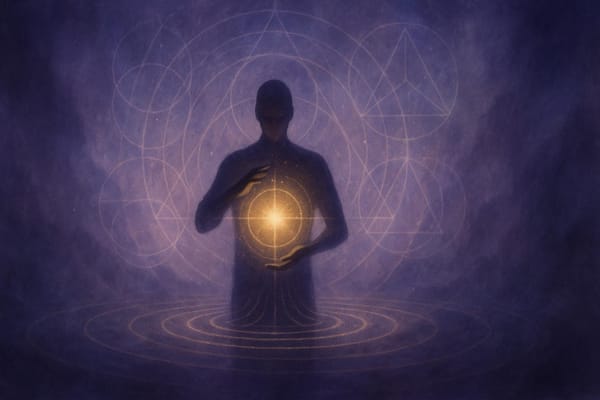Simulation Glitches: Signs and Ritual Responses
Explore the intriguing phenomenon of simulation glitches and their signs, causes, and ritual responses to enhance your understanding of reality.

Simulation glitches are moments where reality seems to "glitch", making us question the world we live in. These anomalies - like time loops, memory discrepancies, or objects appearing twice - might suggest that our reality is not as fixed as it seems.
Here's what you need to know:
-
Common Glitches:
- Time anomalies: Time loops or unpredictable behavior.
- Memory discrepancies: Groups remembering events differently (e.g., Mandela Effect).
- Reality shifts: Sudden, unexplained changes in surroundings.
- Déjà vu: Feeling like you've experienced a moment before.
- Possible Causes: Could these be "breadcrumbs" hinting that reality is a simulation? Quantum mechanics and theories from scientists like Neil deGrasse Tyson suggest it's possible.
-
How to Respond:
- Grounding Techniques: Use sensory exercises like the 5-4-3-2-1 method to regain focus.
- Visualization: Imagine light or energy resetting your mind and body.
- Symbol-Based Practices: Walk barefoot or visualize protective light to realign with your surroundings.
Glitches might be more than strange occurrences - they could be signals or messages. By observing, documenting, and reflecting, you can decode these moments to gain insight into yourself and reality.
Tip: Start by keeping a journal to track strange patterns or events and use grounding exercises to stay centered.
Common Signs of Simulation Glitches
Daily Life Glitch Examples
Simulation glitches often show up in everyday situations that seem to defy logic or challenge our understanding of reality. One well-known example is déjà vu - that eerie feeling of having lived through a moment before, even though you know you haven’t.
Another phenomenon tied to glitches is the Mandela Effect. This occurs when large groups of people remember historical events differently from how they are officially recorded.
While scientists often attribute this to memory errors, some proponents of simulation theory suggest these inconsistencies could stem from small "code rewrites" in reality.
But glitches don’t just happen in the world around us - they can also affect how we feel and perceive things internally.
Mental and Energy Signs
Some glitches seem to manifest as physical or mental sensations. For instance, more than half of people report experiencing derealization at least once in their lives - a feeling where the world around them seems unreal or dreamlike.
Here’s a quick look at some common symptoms and their connections:
| Symptom | Frequency | Associated Conditions |
|---|---|---|
| Derealization | Over 50% experience it at least once | Often linked to anxiety, stress, or depression |
| Depersonalization | 3.3% to 20% among people with anxiety | Common in individuals with anxiety disorders |
These internal sensations can feel unsettling, but they’re often accompanied by external patterns or symbols that suggest subtle shifts in reality.
Repeating Signs and Symbols
Have you ever noticed how, after learning something new, it suddenly seems to pop up everywhere? This is known as the Frequency Illusion.
Traditional psychology explains it as selective attention, but simulation theory offers a different perspective: a reality that adapts and responds to our awareness.
"Synchronicity is an event with specific meaning for the person involved. From another perspective, such an event may not have a clear meaning or is understood as a simple coincidence"
These meaningful coincidences, or synchronicities, often show up during pivotal moments in life, hinting at a responsive or programmed reality. Even nature seems to reflect this idea.
For example, the Fibonacci sequence - found in everything from seashells to galaxies - suggests an underlying order to the universe.
When you encounter these patterns or signs, it’s worth staying curious. While conventional explanations often make sense, there’s no harm in considering the possibility of something deeper at play.
Rituals for Handling Glitches
Grounding Methods
When dealing with simulation glitches, grounding techniques can help you reconnect with the present moment. Studies suggest these methods can reduce anxiety, improve well-being, and ease feelings of dissociation.
| Technique Type | Method | Purpose |
|---|---|---|
| Physical | 5-4-3-2-1 Sensory Exercise | Anchoring to reality |
| Mental | Mathematical Sequences | Restoring focus |
| Energetic | Crystal Connection | Balancing vibrations |
These approaches provide immediate relief. For example, the 5-4-3-2-1 method involves identifying five things you can see, four you can touch, three you can hear, two you can smell, and one you can taste. It’s a simple yet effective way to reorient yourself.
For energetic grounding, stones like Black Tourmaline and Hematite are helpful. Hold them during meditation or place them near your feet to stabilize your energy. You can also create a crystal grid using these stones alongside Smoky Quartz to maintain balance.
Once you’ve physically grounded yourself, it’s time to shift inward with visualization techniques.
Visualization Reset Techniques
After stabilizing your body, visualization can help realign your mind. Dr. Richard Suinn, a sports psychologist for the 1976 Winter Olympics, demonstrated how mental imagery boosts both physical performance and clarity of perception.
Here’s how to get started:
-
Energy Release Protocol
Find a quiet space and imagine a healing light flowing through your body, dissolving any energetic blockages. -
Neural Pathway Realignment
Visualize detailed scenarios that reflect your desired reality. This practice can help reshape neural pathways and reinforce positive patterns. -
Somatic Integration
Tune into your body’s sensations. As Psychiatrist Dr. Bessel van der Kolk explains:"Our gut feelings signal what is safe, life-sustaining, or threatening, even if we cannot quite explain why we feel a particular way… If you have a comfortable connection with your inner sensations - if you can trust them to give you accurate information - you will feel in charge of your body, your feelings, and yourself."
These steps help you recalibrate and regain control of your inner world.
Symbol-Based Alignment
To complement grounding and visualization, consider incorporating symbol-based practices. These methods align your energy with your surroundings, creating a sense of harmony.
| Element | Purpose | Application |
|---|---|---|
| Earth Connection | Physical grounding | Walking barefoot outdoors |
| Energetic Shield | Protection | Imagining a protective light |
| Aura Cleansing | Energy reset | Using specific hand positions |
As one practitioner puts it:
"The Earth is alive with energy, pulsing beneath your feet, calling you to connect. Grounding - the simple yet profound practice of attuning your body and mind to this natural energy - is your gateway to balance, healing, and manifestation."
Another reflects:
"We can let go of a balloon and watch it float through the clouds, but can still feel the earth beneath our feet - allowing ourselves to be present."
These techniques, when combined, offer a powerful way to regain balance and restore your sense of presence.
Understanding Glitch Messages
Reading Glitch Signals
Glitches can offer a glimpse into deeper layers of awareness. Dr. Amaliny Yoganathan explains:
"By becoming more mindful, we might start noticing inconsistencies or patterns in our experiences. Meditation sharpens our perception and makes us more aware of subtle details, including strange or synchronous events."
Here’s a quick look at some common glitch types, their potential meanings, and ways to respond:
| Glitch Type | Potential Message | Response Method |
|---|---|---|
| Memory Overwrites | Errors in memory retrieval | Deep meditation |
| Repeating Numbers | Underlying code patterns | Pattern tracking |
| Synchronicities | Meaningful coincidences guiding our paths | Mindful observation |
Computer Scientist Rizwan Virk adds a scientific perspective:
"While it's hard to falsify whether we are in a simulation, we can find evidence that we are. There are a number of scientists pursuing experiments to show that the mysteries of quantum mechanics are implying that we are in a simulation."
These signals encourage us to decode their meanings, offering an opportunity for personal exploration and growth.
Using Glitch Insights
Ancient wisdom from The Gospel of Thomas provides an interesting lens:
"If you bring forth what is within you, what you bring forth will save you. If you do not bring forth what is within you, what you do not bring forth will destroy you."
By interpreting these messages, we can better align with the simulation's underlying framework and enhance the effectiveness of certain practices. Here’s how you can start:
- Document recurring themes: Keep track of patterns and anomalies you notice.
- Use insights for growth: Apply what you learn to foster personal and spiritual development.
Albert Einstein’s words offer additional depth:
"The distinction between the past, present, and future is only a stubbornly persistent illusion."
Unpredictability can also be a powerful tool. Introducing random changes to your routine may help disrupt ingrained patterns within the simulation, potentially revealing new insights.
Here are some practical ways to work with glitch insights:
| Practice | Purpose | Expected Outcome |
|---|---|---|
| Dream Journaling | Track subconscious patterns | Improved pattern recognition |
| Reality Checks | Verify consciousness state | Heightened awareness |
| Ritual Purification | Clear energetic interference | Better signal clarity |
From a Gnostic perspective, glitches are seen as "cracks in the façade of the material world, moments of insight that revealed its falsity". By observing and documenting these cracks, we can gain a deeper understanding of the subtle messages hidden within our reality.
Conclusion: Working with Reality
Main Points Review
Navigating glitches in reality requires a thoughtful mix of awareness and intentional practices that help manage stress and improve focus.
| Ritual Type | Purpose | Impact |
|---|---|---|
| Morning Practice | Sets intention | Brings stability |
| Mindful Breaks | Maintains awareness | Helps spot anomalies |
| Evening Reflection | Processes experiences | Incorporates insights |
"Ritual is poetry in the world of acts"
These rituals provide a solid framework for handling the ever-changing nature of reality.
Next Steps Forward
Moving ahead requires blending structure with adaptability. Research shows that mindfulness not only boosts mental flexibility but also sharpens concentration, making it easier to respond to the shifting patterns of reality.
"This is what rituals are for. We do spiritual ceremonies as human beings in order to create a safe resting place..."
Here are some practical steps to help you navigate:
- Ground yourself regularly using techniques like Qigong or mindful breathing.
- Keep a journal to track and reflect on your insights.
- Maintain a positive outlook - studies reveal that optimism can reshape both behavior and perception.
Every glitch you encounter is more than just a disruption - it's a chance to grow and adapt. As Psychology Today highlights:
"Words create reality. The inner-dialogue you attach to any given situation makes it a reality in your mind. The subjective nature of reality can create problems and lead to failure if you are someone who is inclined to be negative."
Each challenge is a moment to refine how you engage with the fluid and unpredictable nature of reality. Embrace the opportunities it offers.
Simulation Theory: Are we Trapped in a Fake Reality?
FAQs
What are some signs that could suggest a glitch in the simulation of reality?
Signs that might suggest a glitch in the fabric of reality often show up in curious ways:
- The Mandela Effect: This happens when many people collectively misremember an event or detail, such as the spelling of a familiar brand or the outcome of a historical event. It’s as if reality itself has shifted or been rewritten.
- Déjà Vu: That strange sensation of reliving a moment you’re sure has happened before. Some interpret it as a sign of a system reset or a brief overlap in timelines.
- Uncanny Coincidences: Those moments when events line up with such precision that they feel orchestrated rather than random - like bumping into an old friend right after thinking about them.
These oddities often make us question the nature of existence. Taking time to reflect on these experiences can provide both a sense of balance and a fresh perspective on life’s mysteries.
How do grounding techniques help when dealing with the unsettling effects of simulation glitches?
Grounding techniques can be incredibly helpful when you're feeling unsettled or overwhelmed, especially during moments of uncertainty or discomfort. By shifting your focus to the present moment, these practices can ease anxiety, clear your mind, and bring a sense of emotional steadiness.
Some straightforward grounding methods to try include deep breathing, tuning into your senses (like paying attention to the sounds, smells, or textures around you), and physical grounding (such as holding an object or noticing the sensation of your feet touching the floor). These simple actions help engage your body's natural relaxation response, making it easier to feel connected and centered again.
Making grounding exercises a regular part of your day can help you handle challenging situations with a calmer mindset, giving you the clarity to face whatever comes your way.
Could our reality be a simulation, and are there experiments exploring this idea?
The notion that our reality could be a simulation has sparked interest among both scientists and philosophers.
Physicist Melvin Vopson introduced the Second Law of Infodynamics, a theory suggesting that the universe functions like a digital system, constantly optimizing information and minimizing entropy. This idea connects with philosopher Nick Bostrom’s argument, which posits that advanced civilizations might run simulations of their ancestors, making it statistically plausible that we’re part of one.
To delve deeper into this theory, researchers are designing experiments to detect evidence of a simulated universe. For instance, some physicists are examining whether specific physical phenomena - such as the constraints within quantum mechanics - might reveal traces of underlying 'programming.' These investigations aim to determine if our reality is an intricate digital construct or something entirely different.




